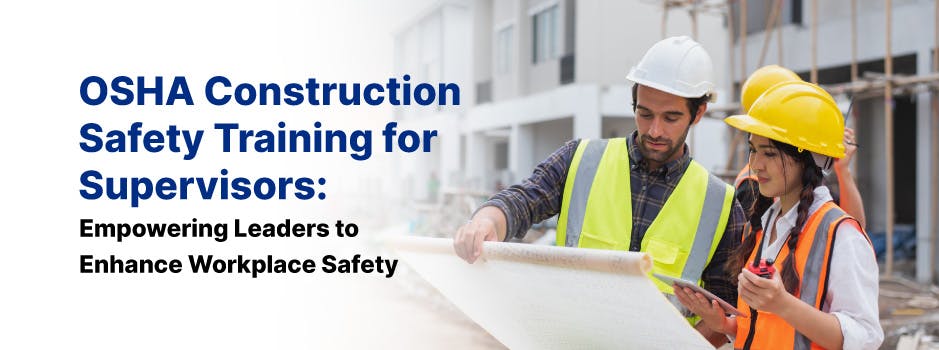OSHA Construction Safety Training for Supervisors: Empowering Leaders to Enhance Workplace Safety
Introduction
Occupational Safety and Health Administration (OSHA) construction safety training is essential for construction supervisors to ensure a safe work environment. This 2500-word article will explore the importance of OSHA construction safety training, the specific topics covered, and the benefits of this training for supervisors and their teams.
I. The Importance of OSHA Construction Safety Training for Supervisors
- Legal compliance: OSHA regulations require construction companies to provide their employees with a safe work environment. As supervisors, it is crucial to understand and implement these regulations to avoid legal issues and potential fines.
- Employee safety: Construction sites present numerous hazards, and supervisors must be able to recognize and address these risks to protect their employees from injury or illness.
- Boosting productivity: A safe work environment promotes employee morale and productivity, leading to better project outcomes.
- Reducing costs: By preventing accidents and injuries, companies can avoid the direct and indirect costs associated with workplace incidents, such as medical expenses, lost productivity, and potential lawsuits.
II. OSHA Construction Safety Training Topics
OSHA 30-Hour Construction Training: This comprehensive course, designed for construction supervisors, provides an overview of OSHA regulations, hazard recognition, and workplace safety practices. Some of the key topics covered include:
- Introduction to OSHA and its standards for construction
- Managing safety and health programs
- Fall protection
- Electrical safety e. Scaffold safety
- Excavation and trenching safety
- Personal protective equipment (PPE)
- Fire prevention and protection
- Hazard communication
Supervisor-specific training: In addition to the OSHA 30-Hour course, construction supervisors should also seek training on specific topics tailored to their roles and responsibilities. These may include:
- Accident investigation and root cause analysis
- Job hazard analysis (JHA)
- Leadership and communication skills for safety
- Contractor management and coordination
- Emergency action plans and response
III. Benefits of OSHA Construction Safety Training for Supervisors
- Enhanced hazard recognition: Through this training, supervisors can identify potential hazards and take proactive measures to prevent accidents.
- Improved safety culture: A well-trained supervisor can effectively communicate the importance of safety to their team, leading to a stronger safety culture throughout the organization.
- Better decision-making: By understanding OSHA regulations and best practices, supervisors can make informed decisions that prioritize safety while maintaining project timelines and budgets.
- Reduced injuries and accidents: Effective safety training can significantly reduce the number of workplace accidents and injuries, leading to lower costs and improved employee well-being.
- Legal compliance: Adequate training helps ensure compliance with OSHA regulations, minimizing the risk of costly fines and potential litigation.
- Career advancement: Demonstrating a commitment to safety can open up opportunities for professional growth within the construction industry.
IV. Implementing OSHA Construction Safety Training
- Choose the right training provider: Research reputable training providers that offer OSHA-approved courses. Look for instructors with experience in the construction industry and a solid understanding of OSHA regulations.
- Customize the training: Tailor the training to the specific needs of your construction site, including the types of hazards present, the size of your workforce, and any unique challenges you may face.
- Set expectations: Clearly communicate the importance of safety training to your team and the expectations for participation and completion.
- Track progress and evaluate effectiveness: Monitor your team's progress throughout the training and assess the impact on safety performance. Use this information to adjust your approach as needed and continually improve safety practices.
V. Continuous Learning and Updating Safety Knowledge
- Stay informed: As construction techniques, materials, and technologies evolve, so do the hazards and risks associated with them. Keep up to date with industry news and participate in professional associations to stay informed about emerging trends and best practices.
- Refresher courses: OSHA regulations and standards may change over time. Regularly participate in refresher courses to ensure your knowledge remains current and relevant.
- Networking: Connect with other construction supervisors and safety professionals to exchange ideas, discuss challenges, and share best practices.
- Attend conferences and seminars: Participate in industry conferences and seminars focused on construction safety to learn from experts and stay abreast of the latest developments.
- Implement a culture of continuous learning: Encourage a learning culture within your team by sharing new knowledge and insights, discussing lessons learned, and promoting ongoing professional development.
VI. Empowering Supervisors for a Safer Construction Site
- Provide necessary resources: Ensure that supervisors have access to the appropriate resources to implement and enforce safety measures, including PPE, safety equipment, and training materials.
- Encourage open communication: Create an environment where supervisors and employees feel comfortable discussing safety concerns and potential hazards without fear of retribution.
- Recognize and reward safety performance: Acknowledge and reward supervisors and their teams for their commitment to safety, including meeting or exceeding safety goals, reporting hazards, and suggesting improvements.
- Engage employees in safety planning: Involve employees in the development and review of safety plans, procedures, and training materials to ensure they are relevant, practical, and effective.
- Foster teamwork and collaboration: Encourage collaboration among team members to identify hazards, share ideas, and develop solutions for a safer work environment.
Conclusion
OSHA construction safety training for supervisors is essential to create a safe and productive work environment. By understanding and implementing OSHA regulations, recognizing and addressing hazards, and fostering a culture of safety, construction supervisors can protect their employees and ensure the success of their projects. Investing in safety training not only leads to compliance with the law but also creates a positive safety culture, reduces accidents and injuries, and promotes career advancement opportunities for construction supervisors.

